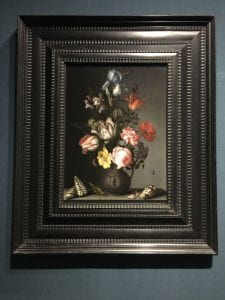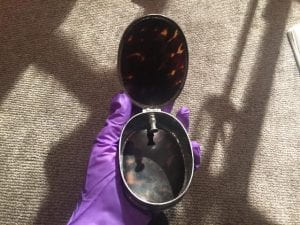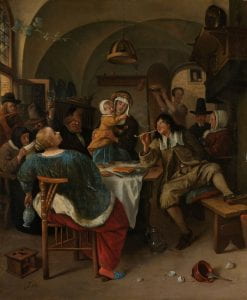Premium Petals: A Luxurious Dutch Tobacco Box
By Anastasia Kinigopoulo, WPAMC Class of 2020

Tobacco Box, Gerrit V. Dyn. Dutch, 1670-76. Silver and tortoiseshell, 1 5/8 x 3 5/8 x 2 ¾ in. Gift of Henry Francis du Pont, 1965.1351. Image courtesy of Winterthur Museum.
In the late 1660s, the Dutch were enjoying a period of profound wealth and cultural richness. Unlike neighboring European states, which were ruled by monarchies, the nation’s leadership essentially consisted of an oligarchy of merchant rulers, and the region enjoyed the fruits of a wealthy and active middle class who could afford a variety of material luxuries. Even still, objects like this silver and tortoiseshell tobacco box, engraved with flowers and capped with two pieces of tortoiseshell, would have remained tantalizingly out of reach of the vast majority of the population.
Flowers held a near-fetishistic sway over Dutch culture during the 1600s, and this box is remarkable for the accuracy of its engraved blossoms. Dancing across the silver band, are, among others, a tulip, a carnation, a morning glory, and an iris (or possibly lily), and two birds. The precision with which the silversmith engraved these flowers recalls the simultaneously booming production of floral still lives.

Balthasar van der Ast (1593/4- 1657), Flowers in a Vase with Shells and Insects, about 1630. Oil on oak, National Gallery of Art, London. Photograph by the author.
As scholar Paul Taylor notes, though these seemingly innocent motifs appear prosaic today, a full bouquet of blooms such as the ones engraved on this box would have cost as much as a month’s pay, even for relatively affluent master craftsmen. Flowers of any sort were typically available to only those with disposable income. Gardens—themselves a rare luxury in real estate starved Dutch cities—were designed specifically for close consideration of the plants growing within them, at the aesthetic expense of the outdoor space they comprised.
The tortoiseshell of this box would have also been a lavish touch. It was most likely obtained from the shell of a hawksbill turtle. Other species, such as the green turtle, were occasionally used for the production of tortoiseshell, but craftsmen preferred the hawksbill turtle for its thicker keratinous scutes—the scales that grow over the shell and are the source of the plastic-like material. Dutch possessions of five islands in the Carribean (Curaçao, Bonaire, Aruba, Saint Eustatius, Saint Martin and Saba) as well as their strong trade relationships in Asia gave the nation ample access to the habitats of both hawksbill and green turtles. As in other countries, the material remained highly precious: archeologists have yet to recover a shred of wasted tortoiseshell in workshop sites, and a tortoiseshell object could cost as much as 800 times one made of horn, wood, or even ivory.

Metal stub for packing tobacco on the inside of the box. Photograph by the author.
Unlike the more typical small boxes made for the consumption of snuff, this object likely meant to hold smoking tobacco. Attached to the hinge on the interior of the box, a small metal stub would have allowed the owner to pack the tobacco into one of the disposable ceramic pipes that so frequently appear in Dutch genre paintings of the period.

Jan Steen, Family Scene, 1660 – 1679. Oil on panel, Rijksmuseum, On loan from the City of Amsterdam (A. van der Hoop Bequest).
Moreover, as Winterthur students in the Craftsmanship course learned in March, archeological sites in the United States continue to recover the sort of pipes that would have been used with this box in mass quantities.

Archeological finds of broken tobacco pipes at Colonial Williamsburg. Photograph by the author.
Impoverished smokers appear in Dutch genre paintings throughout the 17th century, but these figures likely had no relationship to the mystery owner of this box. Whether an immigrant to the colonies or born Dutch, there is little doubt of this owner’s affluence.

Leave a Reply